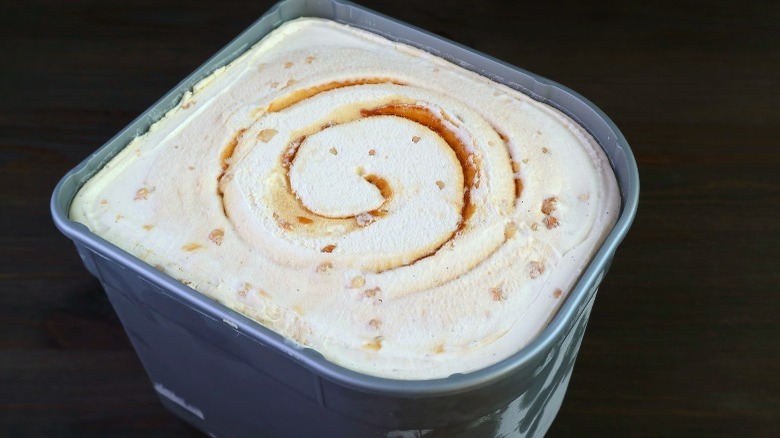The Ingredients That Shouldn't Be In The Ice Cream You're Eating
If the thought of indulging in a delicious scoop of ice cream makes you shiver with excitement, you're not alone. According to Statista, approximately 291 million Americans ate ice cream and sherbet in 2020.
But what may be an even bigger scoop is the fact that ice cream has been around for over a thousand years. According to PBS, it is believed that the precursor to what we know as modern-day ice cream had its origins in China when the emperors of the Tang Dynasty (A.D. 618–907) appeared to have indulged in "a frozen milk-like confection" that included cow, goat, or buffalo milk. To create this frozen sweet, milk was heated with flour and a substance from evergreens called camphor was likely added to provide texture and flavor. The mixture was then lowered via metal tubes into ice pools until frozen.
Sherbet came along a few hundred years later during the medieval period and was introduced by the Arabs, reports PBS. Derived from the word sharabt in Arabic, sherbet was initially an icy beverage that the Arabs would flavor with ingredients such as cherries and pomegranates. The first "official" version of ice cream came along in the 17th century as frozen desserts became more common. Culinary historians say that ice cream as we know it today originated in Naples, Italy thanks to a man named Antonio Latini who created the first milk-based sorbet (via PBS).
How ice cream can be bad for your health
It's pretty much a given that most of your standard ice creams are going to be packed with sugar and fat. However, while you inevitably have to expect sugar and fat content in your ice cream — which, let's face it, may be a big reason why ice cream tastes so amazing — there are even more unhealthy ingredients that could be hiding in that inviting pint that you should try to avoid.
According to the experts at Healthline, many ice cream products are processed and include additives, some of which may have negative impacts on your health. For instance, artificial colorings such as Red No. 3 (erythrosine) and Blue No. 2 (indigo carmine), commonly found in ice cream, have been linked to behavioral problems in children. Another additive found in many ice creams is guar gum, which can give ice cream more texture and thickness. While generally considered safe, guar gum has been found to cause bloating and gas in some people. Likewise, carrageenan is an ingredient found in ice cream that research has suggested may cause gastrointestinal issues, per Healthline.
In regard to which ice cream you should indulge in, "Choose the ice cream that has the fewest ingredients and follows a recipe you could make at home," Boston-based Laura Hartung, a registered dietitian and nutritionist, tells University Health News Daily. And as far as a healthy portion? "Half a cup of ice cream can be worked into a healthy day of eating," she adds.


